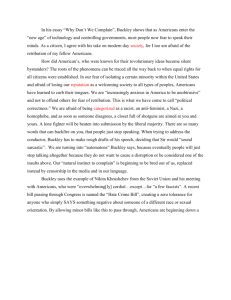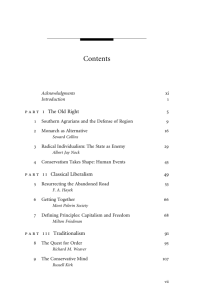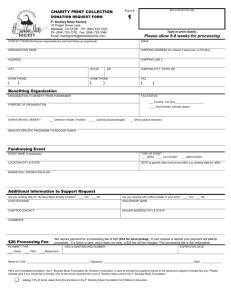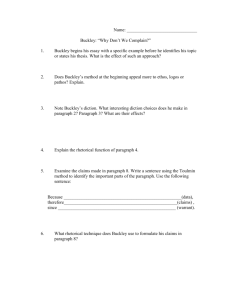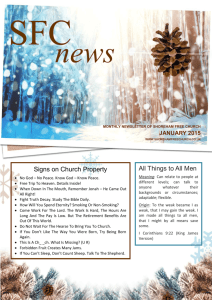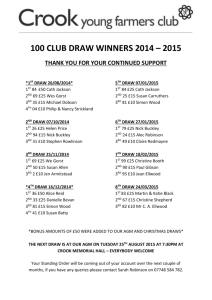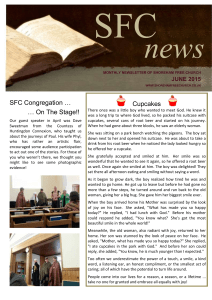Another Side of the Sixties: Young Americans for Freedom and the
advertisement
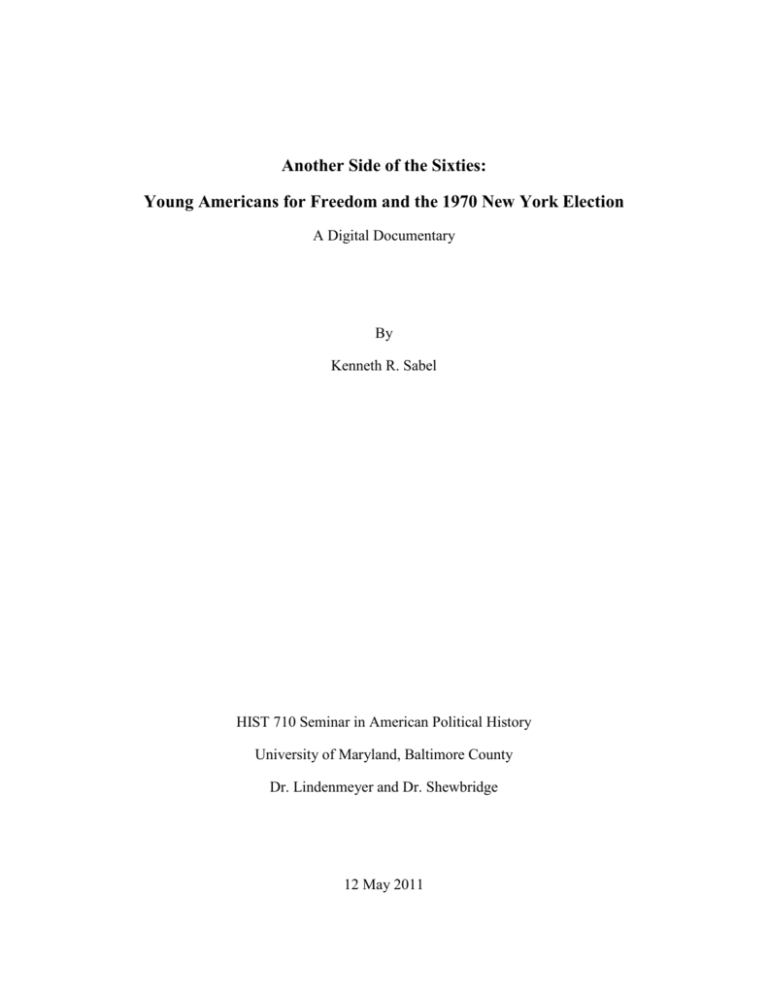
Another Side of the Sixties: Young Americans for Freedom and the 1970 New York Election A Digital Documentary By Kenneth R. Sabel HIST 710 Seminar in American Political History University of Maryland, Baltimore County Dr. Lindenmeyer and Dr. Shewbridge 12 May 2011 Another Side of the Sixties: Young Americans for Freedom and the 1970 New York Election OPENING TITLES AND CREDITS VO 1 Introduction The latter part of the 1960s was a turbulent time in FADE IN RIOTS CLIP W/O AUDIO American politics. Demonstrations against the Vietnam War became increasingly volatile. Many students took to the streets to protest what they viewed as an unjust war. The levels of violence and destruction escalated. In May 1970 National X FADE TO KENT STATE GUARDSMEN AND Guardsmen opened fire on protesting students at Kent JOHN FILO IMAGES State, killing four of them. Less than three months X FADE TO STERLING HALL INTERIOR AND later one person was killed when a bomb exploded in EXTERIOR IMAGES front of a University of Wisconsin physics lab.1 The chaos on college campuses and city streets drew considerable media attention to the perpetrators.2 VO 2 Another side X FADE TO YAF PROTESTERS (2 IMAGES) But there was another side of the sixties, a conservative side. When the Republican Party failed to X FADE TO 1960 GOP CONVENTION IMAGE nominate Senator Barry Goldwater as vice president during the 1960 Republican National Convention, conservative youth activists gathered in September of X FADE TO GREAT ELM GATE that year at Great Elm, the family estate of National X FADE TO GREAT ELM HOUSE Review publisher William F. Buckley in Sharon, X FADE TO YAF LOGO Connecticut and formed Young Americans for Freedom, referred to as “YAF.”3 By 1966 the X FADE TO YAF/SDS COMPARISON organization had 28,000 members nationwide, 1 Another Side of the Sixties: Young Americans for Freedom and the 1970 New York Election compared with 2,000 members in Students for a Democratic Society, known as the SDS.4 VO 3 Conservative Activists X FADE TO ANTI-WAR IMAGE While some members of the SDS at universities such as Berkley and Columbia attracted considerable media attention with their anti-war demonstrations, many X FADE TO IU PRO-WAR DEMO IMAGE conservative students, such as those at Indiana University, staged pro-war demonstrations calling for X FADE TO IU_BAKE-IN IMAGE victory in Vietnam and sponsored events such as bakeins where students baked cookies for the troops.5 Most conservative youth activists believed the best way to X FADE TO VOTING MACHINE IMAGE bring about change was to work within the system. X FADE TO 1970 NY MAP IMAGE Nowhere was this more evident than the 1970 New DISSOLVE TO & ZOOM ON BUCKLEY York election. For the second time in two years, the FAMILY IMAGE Conservative Party nominated James L. Buckley, brother of William F. Buckley, to be their candidate for the United States Senate.6 and the Young X FADE TO BUCKLEY VICTORY IMAGE Americans for Freedom played a major role in their victory.7 DISSOLVE TO BUCKLEY INTERVIEW TITLE “Hon. James L. Buckley” Buckley Video Sequence B1 “United States Senator from New York” So it was not until 1970, when thanks to the showing I did two years earlier, I suddenly emerged as a plausible candidate for actual election, and that is when suddenly I felt the impact of, of YAF, Young Americans for Freedom, and ah they were indispensible ah for my election. 2 Another Side of the Sixties: Young Americans for Freedom and the 1970 New York Election VO4 Buckley Campaign I X FADE BUCKLEY CAMPAIGN BUTTON Buckley faced an uphill battle in a three-way race X FADE IMAGE OF GOODELL IN against two members of Congress, incumbent Senator LOWER LEFT SCREEN Charles Goodell, a Republican congressman appointed to complete Robert Kennedy’s term, and FADE IN IMAGE OF OTTINGER IN Representative Richard Ottinger, the Democratic nominee. But the Buckley campaign had an “essential UPPER RIGHT SCREEN secret ingredient.”8 Youth for Buckley, an army of XFADE TO AND ZOOM TIGHT TO WIDE ON STUPP IMAGE HWS1C young activists recruited almost exclusively from the ranks of Young Americans for Freedom, canvassed neighborhoods and shopping centers distributing campaign literature and washing windshields to promote their candidate.9 VO 5 Where they are from X FADE TO STUPP IMAGE HWS1D Many Young Americans for Freedom came from lower-middle and working class families, reflecting their parents’ patriotism and strong work ethic.10 X FADE TO STUPP IMAGE HWS3B Herb Stupp, of Queens, New York was typical of many “YAFers.” A first generation American, and a Catholic, Herb grew up in Queens and graduated from Saint John’s University, one of the largest Catholic colleges in the country.11 Herb’s conservative political leanings started early…. DISSOLVE TO STUPP INTERVIEW Stupp Video Sequence S1 3 Another Side of the Sixties: Young Americans for Freedom and the 1970 New York Election TITLE “Herb Stupp” I started becoming interested in conservatism as a teenager, but of course the culture in the schools didn’t promote that and especially not in the New York City schools, but I was really captivated by Ronald Reagan’s speech in 1964 watching with my dad, and my father I remember my father saying, “ that’s the guy who should be president” because he did such a good job advocating for Barry Goldwater. SECOND TITLE “Former Youth for Buckley Chairman” DISSOLVE TO REAGAN CLIP KEEP STUPP AUDIO GOING VO 6 Campaign roles X FADE TO GOLDWATER CAMPAIGNING After Goldwater’s crushing 1964 defeat, Young IMAGE Americans for Freedom regrouped and focused on building leadership for future campaigns. YAF X FADE TO BUCKLEY CAMPAING SIGN members played key roles in Buckley’s 1970 campaign.12 Herb was also the New York State X FADE AND ZOOM ON STUPP/BUCKLEY Chairman of Young Americans for Freedom. The IMAGE former senator recalled, “The thousands of young TITLE “The thousands of young volunteers brought an extraordinary energy to my campaign … they could well have been the decisive factor in my winning a very tight three-way race.” James L. Buckley volunteers brought an extraordinary energy to my campaign … they could well have been the decisive factor in my winning a very tight three-way race."13 VO 7 Nixon Westchester stop X FADE TO NIXON IMAGE When President Nixon made a brief stop at the Westchester County Airport in New York, Stupp generated media exposure for the candidate by organizing a large group of young campaigners to greet the president waving “Buckley/Nixon” signs. The event cast Buckley as a possible unofficial Republican candidate to counter Goodell’s 4 Another Side of the Sixties: Young Americans for Freedom and the 1970 New York Election increasingly leftward drift.14 DISSOLVE TO STUPP INTERVIEW Stupp Video Sequence S2 It was a way for us to demonstrate that Buckley, Buckley supporters, were in sync with what the president was trying to accomplish, at least in certain areas. And it would also, more importantly, show that perhaps Buckley was becoming the offic...the unofficial Republican candidate, as Goodell kept going farther and farther out to the left and also dropping in the poles. VO 8 Fun in the campaign The campaign was not all work though; there was still X FADE TO JOHN WAYNE IMAGE time for fun. Actor John Wayne was a staunch conservative and a member of YAF’s National Advisory Board.15 Senator Buckley recalls taking a X FADE TO CHISUM POSTER IMAGE group of his young campaign volunteers to see Chisum.16 Buckley Video Sequence B2 DISSOLVE TO BUCKLEY INTERVIEW The contact with them was fun among other things. I recall early on ah going with, celebrating with the first meeting with, with the key people in the YAF ah ah Young ah Youth for Buckley, celebrating the occasion by going to a John Wayne movie … John Wayne actually contributed a TV plug for me, in which ah he sent a raw piece of video in which he, in cowboy uniform, walks up to a stool, sits down, looks into the camera and says, “You can bet my boots that I would vote for New Y.. Jim Buckley if I were a New Yorker.” And that was in celebration of that piece that we went and saw his movie. There was that sort of fun. 5 Another Side of the Sixties: Young Americans for Freedom and the 1970 New York Election VO 9 Inspiration for youth XFADE & PAN LEFT TO RIGHT ON STUPP IMAGE HWS1C The voting age was still 21 in 1970, so none of the Youth for Buckley volunteers could vote for their candidate, yet they enthusiastically canvassed X FADE TO STUPP IMAGE HWS1D neighborhoods and shopping centers urging others to vote for him. Why did these young activists choose to work within the system for change? Senator Buckley believes it was a sense of patriotism.17 DISSOLVE TO BUCKLEY INTERVIEW Buckley Video Sequence B3 The bomb throwers and flag burners got all the press, but ah the Unites States then, and I hope it continues to be a basically conservative in its instincts and its cultural references. And so you had all over the country these ah young people in college, or even high school who were saying, “Look, I love the flag, I believe in this, I want to do something about it.” VO 10 Anti-Communist influence Anti-Communism played a significant role in attracting youth activists to the conservative X FADE TO SHARON STATEMENT IMAGE movement. The Sharon Statement, YAF’s founding ZOOM TO LAST LINES document, spoke in very general terms regarding its TITLE SCREEN WITH SHARON STATEMENT ON COMMUNISM definition of liberty and the purpose of government. However, on the subject of Communism, the founders of Young Americans for Freedom were unequivocal. International Communism was “the greatest single threat” to American liberties.18 6 Another Side of the Sixties: Young Americans for Freedom and the 1970 New York Election DISSOLVE TO STUPP INTERVIEW Stupp Video Sequence S3 Once I started getting more and more interested in conservatism through anti-Communism, I saw the value of freedom, limited government, capitalism, uhm, voluntary approaches to problems and a reliance more on local government versus federal solutions where possible. VO 11 Their background X FADE TO EVANS IMAGE M. Stanton Evans, one of the founders of Young Americans for Freedom and the primary author of the Sharon Statement, believes most conservative youth activists came from families of modest means and a strong work ethic.19 Many also came from immigrant families who had experienced the horror of totalitarian states.20 Herb Stupp’s parents emigrated from STUPP HIGH SCHOOL IMAGE Germany. His father came to America in April 1929 to escape the economic ravages of the Weimar Republic X FADE TO STUPP EMAIL EXCERPT IMAGE following World War One. His mother emigrated from Berlin in 1947 after surviving a Nazi labor camp and seeing her grandparent’s home confiscated by the Soviet army. Herb believes his parents’ experiences undoubtedly “influenced our dinner table discussion and my own emerging political views.”21 DISOLVE TO STUPP INTERVIEW Stupp Video Sequence S4 Being from an immigrant family, an immigrant family that had difficulties with the Nazis and the Communists, I think there are a number of people from that era who were involved in the conservative movement who say that people who have had 7 Another Side of the Sixties: Young Americans for Freedom and the 1970 New York Election experience with Communism and totalitarian societies sometimes make the best conservatives because of that direct dust up with the real, real brutality of the state. VO 12 Conflicts between Left and Right Conservative views were not appreciated by some. XFADE TO STUPP HIGH SCHOOL IMAGE Herb received a personal death threat and recalls a particularly gruesome threat at another university 22 DISOLVE TO STUPP INTERVIEW Stupp Video Sequence S5 … but at Columbia, you know some of the guys I became friendly with, ah, they went through a lot. You know, a guy had a freshly cut pig’s head put at his door, um you know, as he a..aw..awoke one morning. VO 13 Influence of YAF on later careers I Many former Young Americans for Freedom began moving into leadership positions in federal as well as X FADE TO, ZOOM, PAN RIGHT TO LEFT ON IMAGE OF ELLIOT ABRAMS local and state governments from the late 1970s to the present. Elliot Abrams, a YAF member from Harvard, later served as chief of staff for Senator Daniel P. Moynihan and later as an Assistant Secretary of State X FADE TO MEIER IMAGE LEFT SCREEN ADD NOZZOLIO IMAGE RIGHT SCREEN in the Reagan administration.23 Ray Meier and Michael Nozzolio were Youth for Buckley leaders. Meier was Oneida County Executive and later served ten years in the New York State Senate. Nozzolio is currently a New York State Senator.24 VO 13A Influence of YAF on later careers II Senator Buckley had some thoughts on why so many 8 Another Side of the Sixties: Young Americans for Freedom and the 1970 New York Election former Young Americans for Freedom became DISSOLVE TO BUCKLEY INTERVIEW candidates for elective office themselves… Buckley Video Sequence B4 First of all they had to have an interest in the political dimensions of the country … YAF, ah, ah, was a wonderful training course … They got involved in campaigns like mine, which means getting your, rubbing your hands into the nitty gritties of how the electoral process works. And ah there’s something infectious about that kind of involvement … most college kids today will read about it and say “I’m enthusiastic,” but don’t actually get into the machinery. Once you get into the machinery, I think it can be contagious. VO 14 Influence of YAF on later careers III The youth activists’ association with Young Americans for Freedom made lasting impacts on their careers. After six years as editorial director for WORSTUPP IMAGE HWS4b (at desk) PAN LEFT TO RIGHT TV in New York, Herb Stupp was appointed by the Reagan administration to the first in a series of STUPP IMAGE HWS5b (at podium) ZOOM AND PAN LEFT TO RIGHT increasingly responsible positions in the federal government. He served with distinction as the Commissioner of the New York City Department for STUPP IMAGE HWS6 (with Mayor) ZOOM AND PAN ON MAYOR the Aging earning accolades from New York Mayor Rudy Giuliani.25 Herb’s experiences with Young Americans for Freedom gave him the executive skills to function successfully in these demanding positions. DISSOLVE TO STUPP INTERVIEW Stupp Video Sequence S6 …You got real leadership training that is tough to duplicate, you know, I have some friends who got 9 Another Side of the Sixties: Young Americans for Freedom and the 1970 New York Election some of this when they were in Jaycees, in the Junior Chamber of Commerce, I didn’t really have a need to go into that, even though I went to some of their charitable events because I got all that through YAF and YAF in some cases sponsored officially leadership conferences to teach people how to organize, how to deal with people … I think it made me a better executive for the future, all those human relations, and I became a much more adept manager of people over the years because of those human experiences in YAF VO 15 Influence of YAF on careers II YAF members made a difference later in Jim XFADE TO BUCKLEY PORTRAIT Buckley’s career, after his term in the United States Senate. The former senator recalls… DISSOLVE TO BUCKLEY INTERVIEW Buckley Video Sequence B5 One particular guy who was at Yale Law School who came into New York on weekends in order to work in my campaign, whom I had never met and so on, ended up being the guy who suggested that I be ah nominated for a federal judgeship. In those, in the intervening years he had gone on to become a professor of law uh and then had ended up in the Reagan Justice Department as part of a little group trying to figure out who it was that to ah to nominate to fill vacancies as they came on. So my debt to YAF continued well on throughout my career. VO 16 Conclusion FADE IN RIOTS CLIP W/O AUDIO During the latter part of the 1960s, with the very fabric of American society at risk of being shredded, the media then and historians in later decades focused much attention on the left wing liberal youth activists who sought change on university campuses and in the streets, often with violence and destruction. But there 10 Another Side of the Sixties: Young Americans for Freedom and the 1970 New York Election was another side of the sixties. A conservative side, XFADE TO YAF REAGAN SUPPORTERS where the sons and daughters of working class XFADE TO UNIV OF WISC BOMBING Americans sought change, not in the streets with rocks and firebombs, but in the voting booth with ballots. XFADE TO VOTING MACHINE Many later served with distinction in many levels of QUICK FADE IN IMAGE OF ABRAMS LEFT ADD IMAGES OF MEIER, NOZZOLIO TOP RIGHT AND BOTTOM RIGHT government, business, and academia, helping to bring about some of the changes they advocated as youth FADE IN SOUNDTRACK UNDER VO activists. Above all they were driven by a fervent XFADE TO VIDEO CLIP OF FLAG FURLING desire to keep alive the American ideals and values ROLL END CREDITS OVER FLAG MUSIC AND FLAG FADE TOGETHER TO BLACK handed down to them by their parents. Acknowledgements The author gratefully acknowledges the following people and organizations for their contributions without which this work would not have been possible: The Honorable James L. Buckley and Mr. Herb Stupp for graciously agreeing to be interviewed and permitting the sharing of several photographs appearing herein. Brendan Beers and Matt McMahon for their patient assistance and instruction in the mysteries of video editing with Final Cut Express. Drs. Lindenmeyer and Shewbridge, University of Maryland, Baltimore County Research staff at the Drexel Library, Saint John’s University Queens, NY Research staff at the Nimitz Library, U.S. Naval Academy Annapolis, MD My wife, Deborah for her encouragement and toleration of the many long evenings spent in the library and video editing lab. 11 Another Side of the Sixties: Young Americans for Freedom and the 1970 New York Election 1 “Army Experts Sift Rubble for Bombing Clues at U. of Wisconsin Math Center,” New York Times, August 26, 1970, p. 18. Interview with James L. Buckley, video-recorded by the author 24 March 2011 in Sharon, CT (video in the author’s possession). See also Jason S. Lantzer, “The Other Side of Campus,” Indiana Magazine of History 101, no. 2 (June 2005): 153-178, http://search.ebscohost.com. 3 Wayne Thorburn, A Generation Awakes: Young Americans for Freedom and the Creation of the Conservative Movement, (Ottawa, IL: Jameson Books, Inc., 2010), p. 21-25. 4 George H. Nash, The Conservative Intellectual Movement in America Since 1945, (Wilmington, DE: ISI Books, 1998), p. 287-8 5 Lantzer, p. 164. 6 Thorburn, p. 325. 7 Ibid. p. 328. 8 Ibid. p. 331. 9 Ibid. p. 331. Telephone interview with Arnold Steinberg, 29 April 2011. Also James L. Buckley, Speech given at the 50th anniversary of the Sharon Conference in Washington, DC, September 10, 2010, hereinafter referred to as Buckley Speech. Document contained in an attachment to an email from James L. Buckley to the author, February 3, 2011. 10 Gregory L. Schneider, Cadres for Conservatism, (New York: New York University Press, 1999), p. 32-3. See also Nash, p. 272-3. 11 Interview with Herbert W. Stupp, video-recorded by the author 25 March 2011 in Queens, NY (video in the author’s possession). 12 Buckley Speech. See also Steinberg interview. 13 Email from James L. Buckley to the author, March 29, 2011. 14 Stupp interview. See also Steinberg interview. See also Thorburn, p. 331. 15 Thorburn, p. 75. 16 “Youth for Buckley: A Success,” New Guard, December 1970, p.29. 17 Buckley interview. 18 Sharon Statement, Young Americans for Freedom website, http://www.yaf.com/sharonstatement, accessed 23 April 2011. 19 M. Stanton Evans, Revolt on the Campus, (Chicago: Henry Regnery Company, 1961), p. 46-50. 20 Nash, p. 243-4. 21 Email from Herbert W. Stupp to the author, April 23, 2011. 22 Stupp interview. 23 Thorburn, p. 244-5. See also Council of Foreign Relations website, http://www.cfr.org/content/bios/Abrams_bio_Jan11_1.pdf , accessed 25 April 2011. 24 Thorburn, p. 333. See also New York State Senate website, http://www.nysenate.gov/senator/michael-f-nozzolio/bio, accessed 25 April 2011. 25 Herbert W. Stupp resume, sent as an attachment to an email from Herb Stupp to the author, March 25, 2011. 2 12 HIST 710 Kenneth R. Sabel Annotated Bibliography Books Andrew, John A. The Other Side of the Sixties: Young Americans for Freedom and the Rise of Conservative Politics. New Brunswick: Rutgers University Press, 1997. This text actually gave me the idea for the topic of my digital story as I was not aware of a conservative youth movement during the 1960s. It provided a good overview of the subject as well as many additional sources. Evans, M. Stanton. Revolt on the Campus. Chicago: Henry Regnery Company, 1961. The author is one of the founding senior members of Young Americans for Freedom and was the primary author of the Sharon Statement. This book provides an in-depth analysis of the origins of conservatism. The author presents the argument that where liberal youth left home and absorbed the left wing ideology of their liberal professors and rebelled against their parents’ values, conservative youth left home with their parents’ convictions and beliefs. Rather than rebel against them, they in fact defended those beliefs against liberal academia’s assault. Evans’ work helps to answer the question of why campaigns such as Buckley’s was able to attract so much youthful support. Freedman, Samuel G. The Inheritance. New York: Simon & Schuster, 1996. The book corroborates the argument that many conservative youths of the 1960s came from immigrant working class families by researching the path of three immigrant families from Italy, Great Britain, and Poland. Freedman documents the shift among generations in those families from the Roosevelt years where liberal government programs helped sustain them to the conservative era of the 1980s. Nash, George H. The Conservative Intellectual Movement in America, Since 1945. Wilmington, DE: ISI Books, 1998. The author writes of the study of the ideas and philosophy of conservatism, rather than attempting to define it. He describes the rise of the conservative intellectual movement on college campuses in response to the liberal and statist tendencies that government had followed since the 1930s in dealing with a global recession and a world war. The book provides deeper understanding of the origins of conservatism and how it has been transferred to the younger post-war generation. Thorburn, Wayne. A Generation Awakes. Ottawa, IL: Jameson Books, 2010. The author is a former member of YAF and has conducted an exhaustive study of the organization, including numerous interviews with former leaders and members. The book provides an in-depth description of YAF’s origins and growths as well as its decline. It is an especially rich resource for locating other sources. Beyond the scope of Young Americans for Freedom, Thorburn provides a fuller understanding of the conservative movement in general beginning with the post-war era. The on line bibliography and personal correspondence with the author provided an enormous aid to me in locating other materials Wynkoop, Mary Ann. Dissent in the Heartland. Bloomington: Indiana University Press, 2002. Dr. Wynkoop’s work provided material I needed to document conservative student activity on some campuses, in this case Indiana University which was the starting point for many YAF members. HIST 710 Kenneth R. Sabel Schneider, Gregory L. Cadres for Conservatism. New York: New York University Press, 1999. Schneider’s book gave some additional context and corroboration to the argument that many conservative youth activists came from lower-middle and working class families. He also traced the roots of the conservative movement from the immediate post-war era that corroborated much of what Patton wrote on the subject. Journal Articles Lantzer, Jason S. “The Other Side of Campus.” Indiana Magazine of History, 101, no. 2 (2005): 153-178. http://search.ebsohost.com. A comprehensive look at conservative student activists on the Indiana University campus in the late 1960s. The author describes the extensive influence of the Young Americans for Freedom chapter and the some of the political maneuvering going on within the student government similar to that occurring on the national political scene. Newspapers and Magazines Brudnoy, David. “Free Them Now!" National Review 22 (December 1970): 1404. This article described YAF’s activities on behalf of American POWs in Vietnam, but due to time and space limitations, I was not able to incorporate any of it in my documentary. “Army Experts Sift Rubble for Bombing Clues at U. of Wisconsin Math Center.” New York Times. August 26, 1970, p. 18. I used this source to gain background on some of the violence of the left. Carroll, Maurice. "Conservative Campaigners Demonstrate a Polished Expertise." New York Times. October 16, 1970, p. 25. I used this source to corroborate material researched in Thorburn, and Andrew Carroll, Maurice. "Ottinger Runs 2d: Goodell Poor Third." New York Times. November 4, 1970, p. 1, 19. This article, though not directly quoted from, provided some of the political background for the campaign. Fraser, Gerald. "Conservatives Plan to Thwart Campus Disruptions." New York Times, August 9, 1970, p. 41. I was originally going to include material regarding conservative students’ fight against college administrators who permitted radicals to disrupt classes, but again time and space limitations precluded that avenue. Knowles, Clayton. "Buckley Directs Appeal to Voters Who See Liberty Besieged." New York Times, August 9, 1970, p. 35. This article provided some sense of what the public (in as much as a reporter represents the public) was thinking and what their issues were during the campaign. I also used it to corroborate other research material. Weisman, Steven R. “Buckley’s Drive Mobilized the Youth of the New Right.” New York Times, November 7, 1970, p.31. Weisman’s article provided a brief overview of the Youth for Buckley campaign as well as corroboration for material in Thorburn. “Youth for Buckley: A Success.” New Guard. (December 1970), p. 29-30. The article provided additional detail on the theater outing event mentioned in my documentary, it also provided corroboration for the account of Youth for Buckley organizing to greet President Nixon at Westchester airport. It also reinforced the level of involvement of young people in the campaign. HIST 710 Kenneth R. Sabel Manuscript or Archive Materials Buckley, James L. Speech given in Washington DC, Sept 10, 2010 at the Fiftieth Anniversary of the Sharon Conference. Document received as an attachment in an email to the author February 3, 2011. The author was a United States Senator from New York from 1970-77. He also served as an undersecretary of state and for twenty years was a federal appeals court judge. The document provides a first-hand account of conservative youth activism on behalf of his senate campaign. The written material further serves to corroborate statements made by him during the author’s interview March 24, 2011. Buckley, James L. and White, Wendy S. Oral History Transcript, Historical Society of the District of Columbia Circuit, September 1998. http://dcchs.org/OralHistory.asp?OralHistoryID=10&Menu=Documents (accessed March 20, 2011). This document provided a significant amount of background material, which while not directly related to my research, did help me to understand my interviewee better. McDonnell, R. H. A History of the Conservative Party of New York State, 1962-1972. University Park, PA. 1975. PhD dissertation. McDonnell’s dissertation provided significant background data on the New York Conservative Party. It helped me to understand better the progression of the party’s influence and a better understanding of the convergence of events that in part made Buckley’s election possible. Interviews Interview with former United States Senator James L. Buckley, video-recorded by the author 24 March 2011 in Sharon, CT (video in the author’s possession). Interview with Mr. Herbert Stupp, former New York State YAF Chairman and former Chairman of Youth for Buckley. Video-recorded by the author 25 March 2011 in Bayside, New York (video in the author’s possession). These two interviews formed the cornerstone of my project. In addition to the personal knowledge gained from two people very much at the center of my topic, both subjects were most generous and cooperative in sharing with me many personal photographs without which the digital story would not have been possible. Telephone interview with Arnold Steinberg, former press secretary and assistant campaign manager for the 1970 Buckley campaign, 29 April 2011. This brief telephone interview with Mr. Steinberg helped clarify some of the interactions between the campaign, YAF, and Youth for Buckley.
